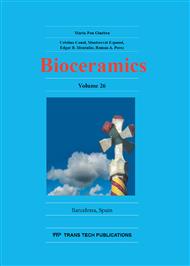p.3
p.8
p.13
p.18
p.25
p.30
p.36
p.43
Electrophoretic Deposition of Zirconia Multilayered Constructs
Abstract:
Zirconia-based ceramics have gained considerable interest for several applications (e.g. solid electrolytes in fuel cells and in oxygen sensors, thermal barrier coatings and biomaterials for dental and orthopaedic applications) due to their high mechanical strength, improved fracture toughness and easy affordability. We constructed both a manual and an automated electrophoretic deposition set-ups, which allowed us to obtain multilayers of alternating tetragonal and cubic phases by layering nanometric sized powders of yttria doped zirconia (Y-TZP) with different mol percentages of yttria (3 % and 8 %). The rationale behind the design of these multilayer constructs was to optimize the properties of the final ceramic by combining the high mechanical toughness of the tetragonal phase of zirconia together with the high ionic conductivity of its cubic phase. These multilayered constructs were proved to have good mechanical integrity and a clearly defined interface between the cubic zirconia grains layer and the tetragonal zirconia grains layer.
Info:
Periodical:
Pages:
13-17
Citation:
Online since:
November 2014
Keywords:
Price:
Сopyright:
© 2015 Trans Tech Publications Ltd. All Rights Reserved
Share:
Citation:


